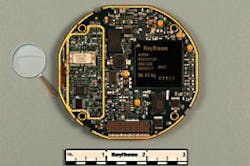Raytheon joins L-3 in program to speed modern anti-jam GPS receivers to the warfighter
Officials of the U.S. Air Force Space and Missile Systems Center at Los Angeles Air Force Base, Calif., awarded a $22.9 million contract modification to Raytheon Thursday as part of the Military GPS User Equipment (MGUE) program.
The contract modification calls for Raytheon to help accelerate the MGUE program by providing pre-prototype GPS receiver cards and test capability to enable faster fielding of M-Code capable GPS receivers to the warfighter.
Earlier this month L-3 Interstate Electronics Corp. (IEC) in Anaheim, Calif., won an $8.5 million contract modification for the MGUE program.
Raytheon specializes in military GPS equipment for avionics,, anti-jam applications, integrated GPS and inertial navigation equipment, and selective-availability anti-spoof module (SASSM) receivers. The company is developing a Modernized User Equipment (MUE) receiver card for next-generation high-performance, low cost Military Code (M-Code) GPS user equipment.
The joint-service MGUE program seeks to develop an updated set of military GPS receivers that provide accurate and reliable positioning, navigation, and timing service where current receiver performance might be compromised or unavailable.
The program seeks to address the increasing threat of enemy electronic warfare jamming of U.S. and allied GPS signals, as well as to deny the enemy the use of U.S. GPS signals. Orbiting GPS IIR-M and IIF satellites are part of the MGUE program, as are GPS III satellites that are in development.
Prototype GPS receiver electronic circuit cards built for the MGUE program are to help add new features into GPS receiver designs. The current maturity of the technology and lower risk levels than expected is enabling Air Force experts to accelerate fielding of several types of MGUE receivers to the U.S. Army, Air Force, Navy, and Marine Corps.
The MGUE also is developing M-Code signals, which are transmitted from modernized GPS satellites. These signals retain all legacy GPS receiver capabilities, yet offers high-power signals with the ability to resist jamming and interference.
M-Code signals also add security features to prevent their use by the enemy, and offer improved message formats and signal modulation for faster and more accurate performance.
Related: Army seeks drastic reductions in the size and power consumption of embedded GPS modules
The MUE program has produced prototype standard-sized military GPS receivers with M-Code and legacy C/A and P(Y) codes. The MGUE program, meanwhile, is developing production-ready GPS receivers for military use.
The Air Force is supervising development of a new, more compact Common GPS Module encompassing the modernized GPS digital application specific integrated circuit (ASIC) technology for use in applications where size, weight, and power (SWaP) need to be minimized.
The Common GPS Module is planned to be the GPS engine for future GPS receivers and other equipment or munitions that require positioning, navigation, and timing capability.
Raytheon has broad military GPS expertise. Raytheon’s Digital Anti-jam Receiver (DAR) provides GPS accuracy and jamming resistance for combat aviation missions. The company's Miniature Airborne GPS Receiver (MAGR) 2000 and MAGR 2000 SAASM is a GPS receiver applications module (GRAM) based open-system architecture. Raytheon’s Anti-jam GPS Receiver (AGR) supports the Tactical Tomahawk cruise missile, and is a Y-code GPS that operates on the L1 and L2 frequencies. The Raytheon Advanced GPS Inertial Navigation Technology (AGINT) is developing an affordable, small, anti-jam GPS receiver system using frequency spatial time adaptive processing (FSTAP).
On this contract modification Raytheon will do the work in El Segundo, Calif., and should be finished by the end of September 2016.
For more information contact Raytheon Space and Airborne Systems online at www.raytheon.com, or the Air Force Space and Missile Systems Center at www.losangeles.af.mil.
